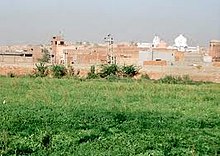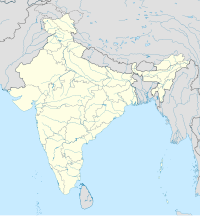Agroha Mound
 Ther Mound | |
Location in Haryana | |
| Alternative name | Excavated Site at Haryana State |
|---|---|
| Location | Agroha, Haryana, India |
| Coordinates | 29°19′54″N 75°37′10″E / 29.33167°N 75.61944°E |
| Type | Settlement |
| History | |
| Founded | 3rd to 4th century BC |
| Abandoned | 13th to 14th century AD |
| Site notes | |
| Excavation dates | 1888–1889, 1978–1979 |
| Archaeologists | C. J. Rogers, J. S. Khatri, Acharya |
Agroha, locally known as Ther, is an archaeological site located in Agroha, in the Hisar district of India.
Location
[edit]The mounds are located about 1.5 km from the town of Agroha, 20 km from Hisar city and 190 km from New Delhi in Hisar district of Haryana, India.[1] It lies on National Highway 9 (old NH-10).
Rediscovery and excavation
[edit]The excavations first started in the year 1888–89 under C.J. Rogers.[2] It restarted in the year 1978-79 by the Archaeological Department of Haryana under the supervision of J.S. Khatri and Acharya.[3]
Belief
[edit]The Agrawal community believes that the archaeological findings are related to their legendary founder—Maharaja Agrasena, whose capital is said to have been at Agroha. Agrawal organizations such as Akhil Bharatiya Agrawal Sammelan and Agroha Vikas Trust have supported archaeological research at the site.[4]
Historical significance
[edit]According to the official website of Hisar, the excavations at Agroha belong to the period from the 3rd-4th century B.C. to the 13th-14th century A.D. A wall for defense, shrine cells and residential houses can be observed in the mound.[5]
Notable artifacts
[edit]Around seven thousand artefacts were recovered during the excavations.
Coins
[edit]Silver and bronze coins belonging to different periods have been found at the site. The coins hoard includes four Indo-Greek coins, one punch-marked coin, and fifty-one coins of Agrodaka.[2] They belong to Roman, Kushana, Yaudheya and Gupta empire. Language used is Prakrit.[2]
Seals
[edit]Many seals have also been found. They are inscribed with words like Pitradutt, " Sadhu Vridhasya", "Shamkar Malasya", "Madrsya", etc.[2]
Others
[edit]Besides the numerous stone sculptures, iron and copper implements and beads of semi-precious stones have also been found.[5]
See also
[edit]- List of Indus Valley civilization sites
- Agroha (town)
- Agroha (temple complex)
- Agrasena
- Buddhist pilgrimage sites in Haryana
- Buddhist pilgrimage sites
- Buddhist pilgrimage sites in India
References
[edit]- ^ "Agroha, district Hissar, Haryana - kingdom of Aggarwals - India - Travel". Archived from the original on 14 November 2012. Retrieved 22 May 2012.
- ^ a b c d "Ancient Mound, Agroha". haryanatourism.gov.in. Retrieved 26 April 2023.
- ^ "Excavation Sites in Haryana - Archaeological Survey of India". Archived from the original on 7 May 2012. Retrieved 22 May 2012.
- ^ Babb 2004, p. 186.
- ^ a b "History of Hisar". Archived from the original on 4 February 2012. Retrieved 22 May 2012.
Bibliography
[edit]Babb, Lawrence A (2004). Alchemies of Violence: Myths of Identity and the Life of Trade in Western India. Sage. ISBN 978-0-7619-3223-9.




